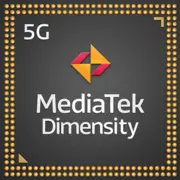MediaTek Dimensity 820

MediaTek Dimensity 820: Balance of Power and Efficiency in the Mid-Range Segment
(Relevant as of April 2025)
Introduction
In the world of mobile processors, MediaTek continues to strengthen its position by offering solutions that combine affordability with modern technology. Released in 2020, the Dimensity 820 remains popular in mid-range smartphones due to its successful architecture and support for 5G. In this article, we will explore what makes this chip noteworthy, who it is suitable for, and how it stacks up against its competitors.
1. Architecture and Technological Process: The Foundation of Stability
Cores and Frequencies
The Dimensity 820 is built on an 8-core architecture with clusters:
- 4 high-performance Cortex-A76 cores with speeds of up to 2.6 GHz for resource-intensive tasks.
- 4 energy-efficient Cortex-A55 cores with speeds of 2.0 GHz for background processes.
This big.LITTLE approach provides a balance between performance and battery life. The L2 cache level is 1 MB, which speeds up the processing of frequently used data.
Mali-G57 MP5 GPU
The Mali-G57 MP5 graphics processor supports Vulkan 1.1 and OpenGL ES 3.2 APIs, allowing for modern games to run at moderate settings. Its 5 compute units (cores) provide sufficient power for rendering graphics at resolutions up to Full HD+.
7nm Technology Process
The chip is manufactured using a 7nm process technology, which reduces power consumption and heat generation. This is particularly important for smartphones with compact bodies, where cooling systems are limited.
2. Real-World Performance
Gaming
- Genshin Impact: Medium settings (30-40 FPS), but may experience drops in performance during battles with effects.
- PUBG Mobile: Smooth gameplay at HD graphics with a frame rate of 60 FPS.
- Honkai: Star Rail: Optimal performance at medium settings (45 FPS).
Multimedia
- Video decoding: Support for 4K@60 FPS (H.265/HEVC, H.264).
- Displays: Adaptation to refresh rates of up to 120 Hz (depending on the smartphone model).
AI Applications
- Neural network acceleration (APU 3.0) improves camera performance: night mode, scene recognition, video stabilization.
- Voice assistants and AR applications work without delays.
Power Consumption and Heat
With a TDP of 8 W, the chip is energy-efficient:
- A smartphone with a 5000 mAh battery maintains 6-7 hours of screen time.
- In multitasking mode (social media, YouTube, navigation), the temperature rarely exceeds 40°C.
3. Built-in Modules: The Communication of the Future
5G Modem
- Support for Sub-6 GHz (but not mmWave), speeds up to 2.3 Gbps.
- Dual SIM 5G: Simultaneous use of two SIM cards on next-generation networks.
Wi-Fi and Bluetooth
- Wi-Fi 6: Speeds up to 1.2 Gbps, stable connections in crowded areas.
- Bluetooth 5.2: Connects wireless headphones with low latency (AptX Adaptive).
Navigation
- GPS, GLONASS, Galileo, QZSS: Positioning accuracy of up to 1 meter.
4. Comparison with Competitors
Snapdragon 778G (Qualcomm)
- Advantages of Snapdragon: Adreno 642L GPU is 15-20% more powerful.
- Disadvantages: Higher device price.
Exynos 1080 (Samsung)
- Pros of Exynos: Better gaming performance (Mali-G78 MP10).
- Cons: Heating issues under prolonged load.
Dimensity 1100 (MediaTek)
- Newer chip: Improved AI accelerator and support for 108 MP cameras.
- However, the Dimensity 820 wins on price: smartphones featuring it are cheaper by $50-$70.
5. Use Cases
Gaming
Suitable for casual games (COD Mobile, Among Us) and moderately demanding titles. For AAA games, settings may need to be lowered.
Daily Tasks
- Smooth interface operation, quick application loading.
- Simultaneous launch of 10-15 browser tabs without lag.
Photography and Video
- Support for cameras up to 80 MP and 4K@30 FPS recording.
- HDR modes, portrait shooting with bokeh effect.
6. Pros and Cons
Pros:
- Energy efficiency of 7nm technology.
- Support for 5G and Wi-Fi 6.
- Affordable device prices ($250–400).
Cons:
- Mali-G57 MP5 is weaker than competing GPUs.
- No support for mmWave 5G.
7. Practical Tips for Choosing a Smartphone
What to Look For:
- Cooling: Liquid cooling systems or graphite plates will improve gaming performance.
- RAM: A minimum of 6 GB for comfortable multitasking.
- Display: AMOLED screen with a refresh rate of 90-120 Hz to unveil the GPU's potential.
Popular Models in 2025:
- Xiaomi Redmi Note 14 Pro: 6.7" AMOLED, 8/128 GB, $349.
- Realme 10 Pro+: 5000 mAh, 120 Hz, $299.
8. Final Conclusion
Who is Dimensity 820 Suitable For?
- Budget Gamers: For gaming at medium settings.
- Users Who Value Battery Life: Up to 2 days of operation in moderate mode.
- 5G Enthusiasts: Fast internet without overpaying.
Key Benefits:
- Optimal price-to-performance ratio.
- Preparedness for future technologies (Wi-Fi 6, 5G).
The MediaTek Dimensity 820 is an excellent choice for those looking for a smartphone that can handle all tasks without the extra cost of flagship specifications. As of 2025, devices with this chip remain relevant thanks to software updates and adaptation to new challenges.
Basic
GPU Specifications
Connectivity
Memory Specifications
Miscellaneous
Benchmarks
Compared to Other SoC
Share in social media
Or Link To Us
<a href="https://cputronic.com/soc/mediatek-dimensity-820" target="_blank">MediaTek Dimensity 820</a>